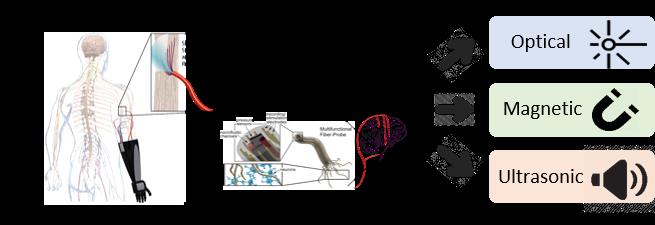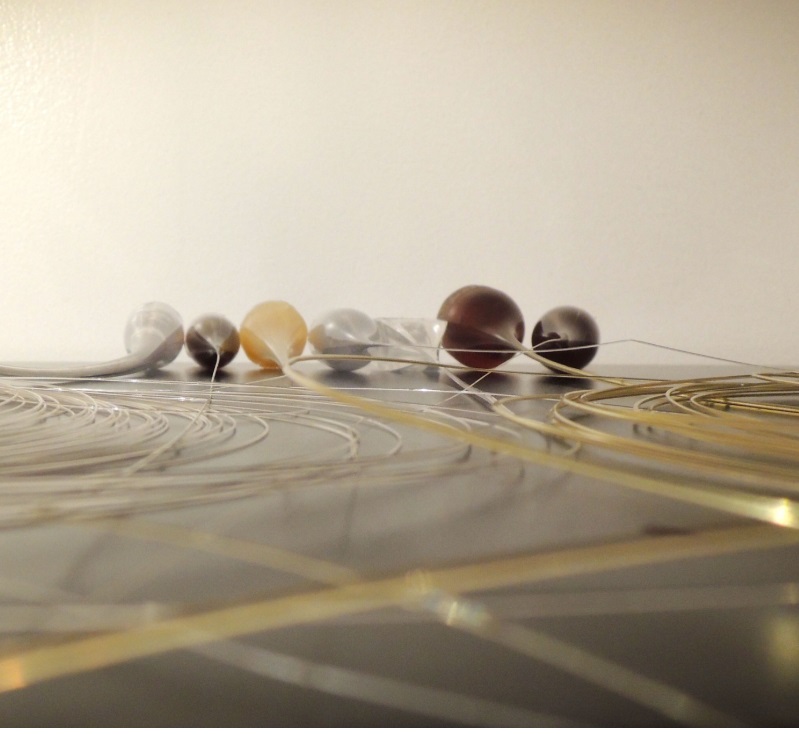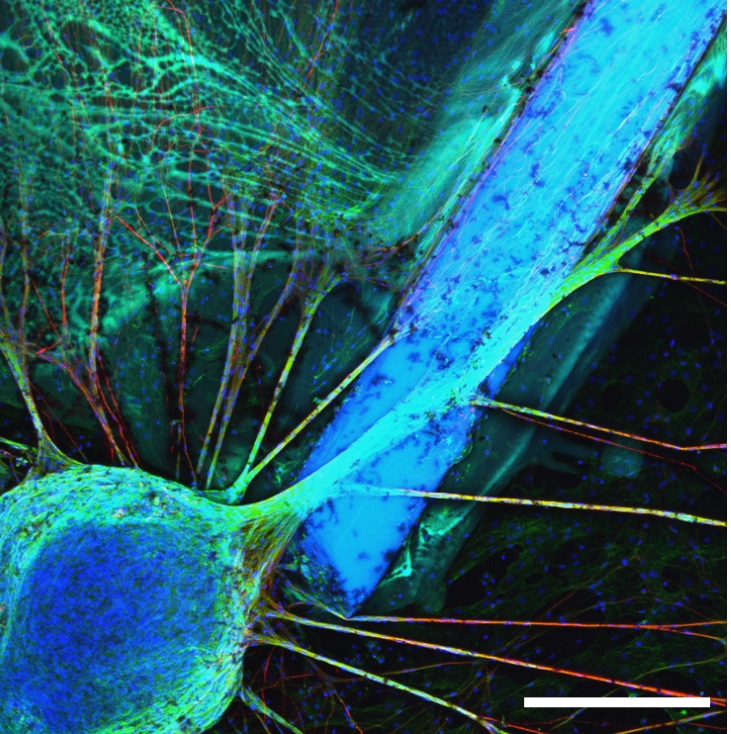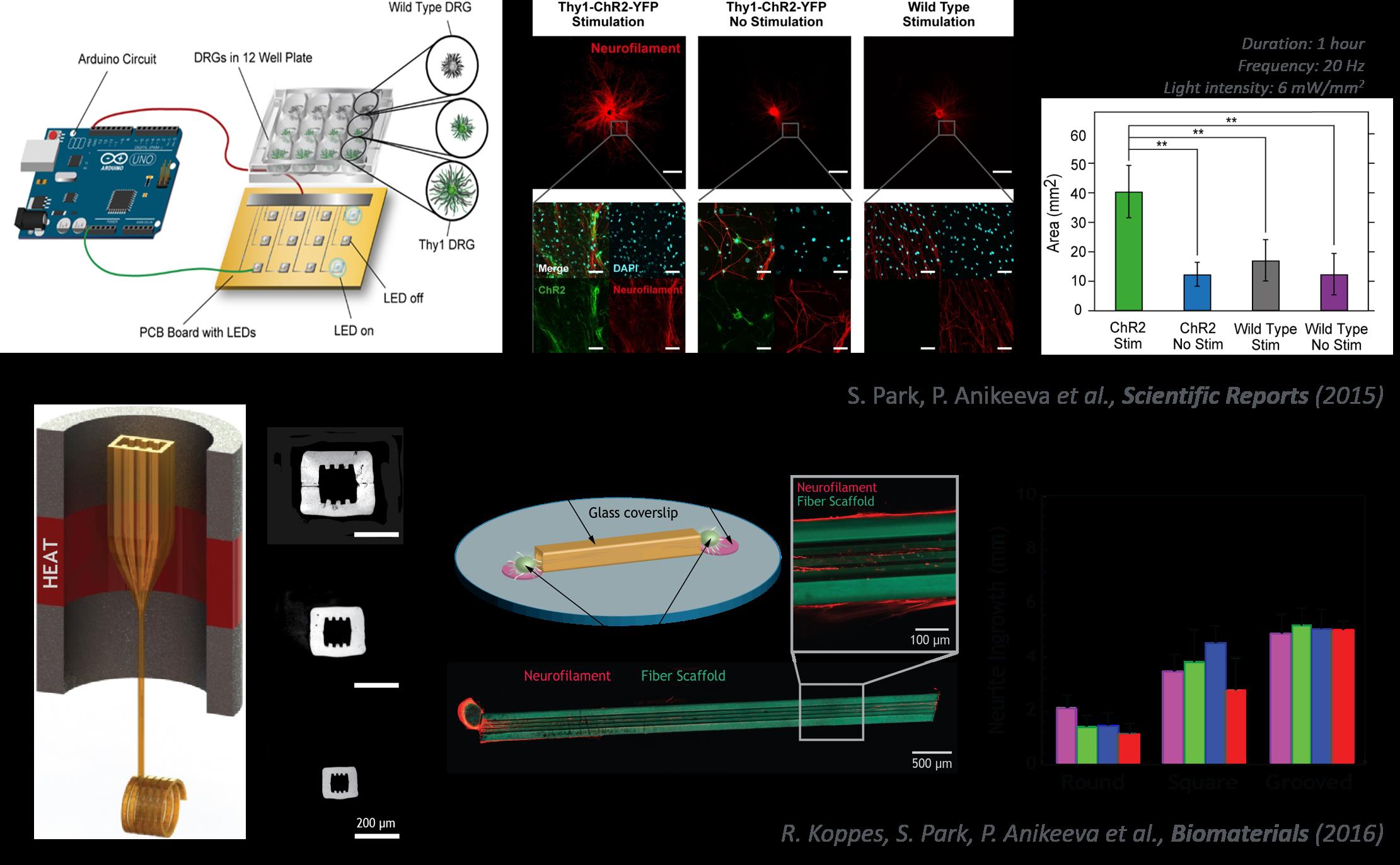
As our population ages, human healthcare problem put an increasing socioeconomic burden on society. Despite the rapid progress in the bioelectronics field, the underlying causes of many biological and neurological conditions remain mostly unclear due to the complexity of the system. Naturally, there is a need to develop reliable engineering tools capable of sensing and modulating the cellular/neural activities. As a solution, we are interested in developing the technologies/devices with multi-modalities such as optical, electrical, magnetic, and ultrasonic for bio and neuro-related applications. Specifically, we are developing various kinds of interfaces from fiber-based optoelectronic probes to nanomaterials for neuromodulation.

Fiber-based Bio & Neural Interfaces

Recent advances in bioelectronics help human not only understand the mechanisms of complicate biological/neurological system but also enable the treatment of related disease. However, practical use of the devices is still limited due to the lack of the flexibility and supposedly caused immune responses. Moreover, integration of diverse modalities within a single biocompatible platform still remains a challenge. Using thermal drawing process, which is conventionally used for the fabrication of optical fibers, we produced miniature and flexible probes with optical, electrical, and microfluidic capabilities all within the dimensions of few tens to hundreds micrometers. These devices allowed to deliver and receive a multitude of neuronal signals not only for brain mapping but also spinal cord modulation in freely moving animals. With this system, we are developing advanced platforms of the fiber-based devices which enables targeting of biological/neural systems in various positions of our bodies. With developments of various materials, structures, and functionalities for the fibers, we will apply them in bio-applications from bio-sensor/actuator to bioelectronic medicine.

Nano-materials for Brain Engineering

To understand the mechanism underlying the function and dynamics of nervous system, it is essential to develop the technique capable of modulating and recording a diversity of signals employed by neuron. However, current approaches are limited in terms of effectiveness, side effects, or mechanical invasiveness due to its bulky body. Consequently, there is a need for new biocompatible materials with multi-modality which allow for minimally invasive manipulation and the specific control of neural circuits. As a solution, we developed the nanoparticle-based magneto-thermal/mechanical/chemical technique for wireless deep brain stimulation. Since biological tissues exhibit negligible magnetic permeability and low conductivity, magnetic fields can penetrate deep into the body with no attenuation, which helps the interrogation with neural circuits across their diverse signaling modalities. Beyond these approaches, we are interested in various nano-materials as a transducers for specific neural control, for example, from piezoelectric nanoparticles to metal nanowire/rods.

Neural Tissue Engineering

Tissue engineering is an interdisciplinary field that applies the principles of engineering and life science toward the development of biological substitutes that restore, maintain, or improve tissue function or a whole organ. In the part of this field, we are especially interested in the technologies to improve the central/peripheral nerve regeneration and investigate the specific mechanism of them. While the clinical importance of this topic, currently there is no perfectly effective treatment strategy following traumatic injury to the nervous system. As a solution, we are interested in applying multimodal stimulation to neuron or using fibers as a scaffold. Specifically, motivated by the findings that electrical stimulation promotes the functional recovery of peripheral nerves, we explored optogenetics as a means to increase neurite growth. Moreover, we confirmed that the fiber drawing process can be applied to biocompatible materials to fabricate nerve guidance channels with scalable topographical features and porous structures on the interior surface of the scaffold. We are further extending these approaches to various tissue with different material platforms, for example, using hydrogel or bio-polymers in stem cell engineering.

- 1. S. Chun*#, J. Kim*, Y. Yoo, Y. Choi, S.Jung, D. Jang, G. Lee, K. Song, K. Nam, I. Youn, D. Son, C. Pang, Y. Jeong, H. Jung, Y. Kim, B. Choi, J. Kim, S. Kim, W. Park, S. Park#, “Artificial Neural Tactile Sensing System,” Nature Electronics4 (6), 429-438, 2021. (*#equally contributed)
- 2. S. Park, Y. Guo, X. Jia, H. K. Choe, B. Grena, J. Kang, J. Park, C. Lu, A. Canales, R. Chen, Y. S. Yim, G. Choi, Y. Fink, and P. Anikeeva, “One-step Optogenetics with Multifunctional Flexible Polymer Fibers”, Nature Neuroscience 20 (4), 612-619, 2017.
- 3. S. Park*, H. Yuk*, R. Zhao, Y. S. Yim, E. Woldeghebriel, J. Kang, A. Canales, Y. Fink, G. Choi, X. Zhao#, P. Anikeeva#, “Adaptive and Multifunctional Hydrogel Hybrid Probes for Long-Term Sensing and Modulation of Neural Activity”, Nature Communications12 (1), 3435, 2021. (*#equally contributed)
- 4. J. Chong*, C. Sung*, K. Nam, T. Kang, H. Kim, H. Lee, H. Park, S. Park#, J. Kang#, “Highly Conductive Tissue-like Hydrogel Interface through Template-directed Assembly”, Nature Communications,In press, 2023. (*#equally contributed)
- 5. C. Lu*, S. Park*, T. J. Richner, A. Derry, I. Brown, C. Hou, S. Rao, J. Kang, C. T. Moritz, Y. Fink, and P. Anikeeva, “Flexible and stretchable nanowire-coated fibers for optoelectronic probing of spinal cord circuits”, Science Advances 3 (3), e1600955, 2017. (*equally contributed)
- 6. Y. Jin*, D. Shahriari*, E. Jeon*, S. Park*, Y. Choi, J. Back, H. Lee, P. Anikeeva#, S. Cho#, “Functional Skeletal Muscle Regeneration with Thermally Drawn Porous Fibers and Reprogrammed Muscle Progenitors for Volumetric Muscle Injury”, Advanced Materials33 (14), 2007946, 2021. (*#equally contributed)






